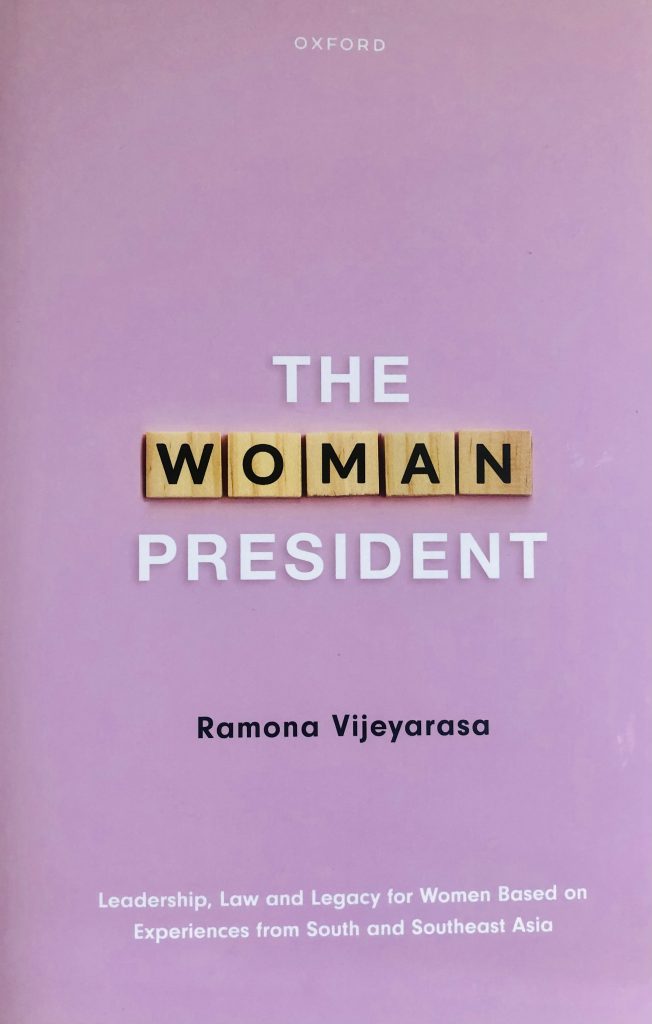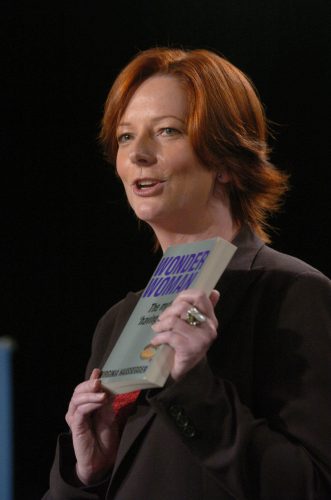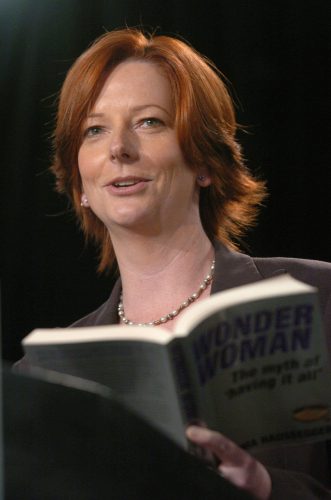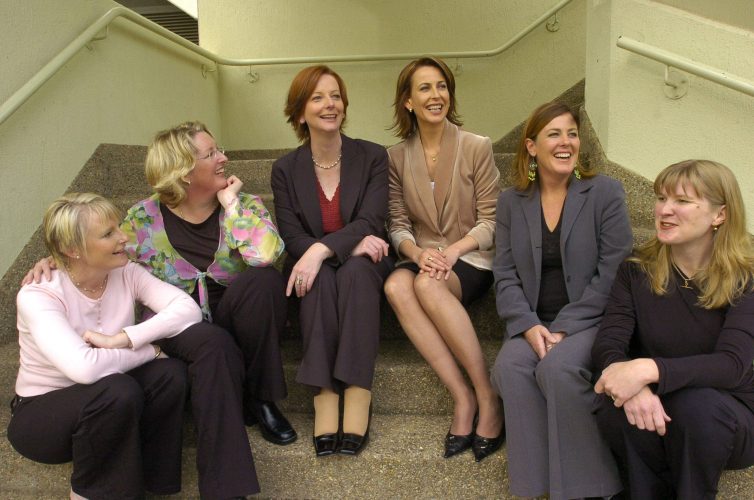| The Woman President: Leadership, Law and Legacy for Women Based on Experiences from South and Southeast Asia by Ramona Vijayarasa, Oxford University Press |
On the eve of the official opening of CHOGM 2011, I sat on stage in Perth with six of the most powerful women in the Commonwealth for a parallel event titled “Empowering Women to Lead”. Invited to MC this novel gathering and facilitate the discussion, I was basking in that rare and fleeting moment in which our worldview of leadership looked surprisingly feminised. The women were in charge!
Queen Elizabeth headed the Commonwealth, and Australia’s prime minister, Julia Gillard, was Commonwealth chair and CHOGM’s host, having just taken the reins from the first female chair, Kamla Persad-Bissessar, prime minister of Trinidad and Tobago. Australia’s governor general, Dame Quentin Bryce, delivered a keynote address at the event, and onstage were half a dozen formidable women, including three prime ministers, ministers for justice and finance, and the EU high representative for foreign affairs and security.
All charmingly charismatic in their own right, it was Bangladesh’s prime minister, Sheikh Hasina, who fascinated me most. Currently the world’s longest serving female head of government, Hasina sat veiled and draped in a golden-bronze sari, looking a picture of maternal genteelness and serenity. Her quiet but distinguished presence oozed “mother of the nation” authority. Back then, I’d never seen female power up close that looked so unapologetically . . . feminine.
At the time, I wondered if such overt expression of femaleness was a danger for a woman leader. My other companion onstage, Julia Gillard, perhaps believed so. This was a year before her misogyny speech and a time when Australia’s PM still refused to acknowledge gender as a factor in her leadership, preferring instead a “gender-neutral” identity.
But we’re older and wiser now. And we know that gender “doesn’t explain everything, it doesn’t explain nothing, it explains some things”.
In her brilliant, timely and meticulous book The Woman President, Ramona Vijeyarasa nails this truth when she concludes, “Gender for the woman (leader) is a second skin that cannot be shed”. She peels back the layers, scale by scale, to reveal what it’s like to be a female in charge of political systems designed by and for men, and how well women leaders deliver for women. Or don’t.
In simple terms – although there is nothing simple about this forensic investigation – Vijeyarasa, a senior law lecturer at Sydney’s University of Technology, provides a fascinating comparative study of the legal legacies and feminist or female- friendly footprint of four South Asian women presidents: the Philippines’ Corazon Aquino (1986–1992) and Gloria Arroyo (2001–10); Indonesia’s Megawati Sukarnoputri (2001–04); and Sri Lanka’s Chandrika Bandaranaike Kumaratunga (1994– 2005). Other than Arroyo, who followed in Aquino’s footsteps, all were the first female president of their country.
While each woman is distinct in manner and style and faces a different set of challenges, as Vijeyarasa is careful to explain, there are shared themes. None of the four rose to power on the back of women’s movements and none identified as feminists, “nor articulated an explicit women’s rights agenda”, yet at times they all presented themselves specifically as a “woman leader”. According to Vijeyarasa, all four “attempted to gain from the framing of female leadership as a socially beneficial form of leadership”, which occasionally meant milking the maternal image for its “cleansing effect”, particularly in the face of corrupt political opponents. For Aquino, such presentation included repeated reference to herself as “just a housewife” or even a “crusading housewife”.
But of course women are both feared and revered, often in the same moment. In 1999 Megawati Sukarnoputri, who fashioned herself as “Mother Mega” and whose propaganda posters drew on images of “the mother goddess”, had stirred a frenzy of religious and media bile, simply for being a woman who dared run for president. Her claim to political power – in the world’s largest Muslim state – led the Congress of Indonesian Muslims (KUI) to call for a fatwa challenging female leadership, making her elevation to president in 2001 all the more remarkable.
Vijeyarasa’s study of these four history-making presidents is breathtaking in scope and ambition, and groundbreaking in methodology. But unfortunately the language and layout of academic scholarship make this narrative a little lumpy at times, which is a shame as there is a wealth of invaluable, original insight buried in this untold comparative story of women’s leadership.
Her primary question “Do women leaders serve women well?” beckons numerous sub-questions. Most importantly, what are “women’s issues” beyond the obvious – equal rights; reproductive freedoms and health; protection from violence; and increasing economic and political participation? Which women are served and which are not? How are they served? What’s the measure?
In an exhaustive attempt to show how the sausage is made, Vijeyarasa has developed a world- first tool, the Gender Legislative Index (GLI) – a legal index that uses human evaluators and machine learning to evaluate laws and provisions in order to measure their gender-responsiveness. Funnelled through the GLI, each law passed during the tenure of the four presidents (a total of some 2000) is benchmarked against the United Nations’ Convention on the Elimination of All Forms of Discrimination against Women, an international treaty that promotes gender equality.
What emerges is no simple score, but rather a web of political and gendered complexities that shadow the woman president’s every move. Each woman proves to be highly strategic, yet “caged by the political context in which they lead”. At times, that underbelly is highlighted by exposing where a leader fails women. For example, President Arroyo claimed credit for the passage of the Philippines’ Magna Carta of Women (2009), an “all-encompassing law” that prohibits discrimination against women and, perhaps most impressively, declares both gender equality and gender equity as state goals. However, Vijeyarasa’s investigation finds ample reason to view Arroyos’s commitment to this powerful instrument as “weak” at best. Noting, too, her declaration, “I will veto any bill that will try to smuggle in abortion.”
Similarly Megawati’s passage of the Elimination of Violence in the Household Act was said by activists to be a “gift to women” in the final days of her tenure. Yet Vijeyarasa suggests such “acclimation is inappropriate” given the late hour. That said, each of the three nations under study passed their first stand-alone laws against gender-based violence during the tenure of the woman president.
Aquino surfaces as perhaps the standout leader for women, with the most extensive and consistent female-friendly legislative program. The Philippines has always rated significantly higher than Australia on global gender gap indices. Aquino had a sharp eye on economic opportunities for women when she introduced paid maternity leave almost twenty years before Australia, and nailed gender-responsive budgeting well before Canberra even understood it.
But perhaps the most profound effect each woman president has had is the least measurable: role modelling. Their sheer visibility as powerful women on national and international platforms has untold impact on gendered perceptions around leadership. Currently only twenty-eight out of 195 nations have a woman in charge. Across the globe, women have never accounted for more than 15 per cent of executive leadership positions. The Woman President is a powerful study on why this must change.
This review was first published in Australian Foreign Affairs, Issue 17, February 2023






